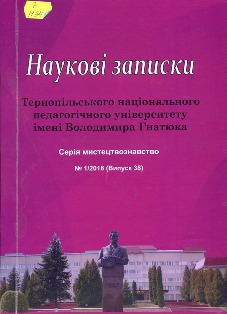МЕТОДИЧНІ АСПЕКТИ ЕСТРАДНОГО ВОКАЛЬНО-ІНСТРУМЕНТАЛЬНОГО АНСАМБЛЕВОГО ВИКОНАВСТВА
Ключові слова:
ансамбль, вокально-інструментальне виконавство, баланс, метроритм, динаміка, технікаАнотація
У статті визначено музично-естетичний потенціал ансамблевого вокально-інструментального виконавства. Зазначено, що задля досягнення збалансованого і гармонічного звучання ансамблю необхідно здійснювати планомірну роботу з усіма учасниками гурту. Виокремлено наявність технічних вимог, дотримання яких може бути пов’язаним тільки з колективним музикуванням. Підкреслено велике значення метроритмічного та динамічного балансу в звучанні колективу. Підсумовано важливість знання різних виконавських стилів та вміння працювати зі звукопідсилювальною апаратурою і комп’ютерним устаткуванням.Посилання
Bychkov, O. V. (2006), “Formation of ensemble technique of the musician-performer”, The dissertation of the candidate of pedagogical sciences. Specials 13.00.02, St. Petersburg State University of Culture and Arts, St. Petersburg, 188 p. (in Russian).
Gigov, K. A. (1977), “The main problems of performing on the wind instruments in the chamber ensemble: (On the example of the wind quintet: flute, oboe, clarinet, French horn and bassoon)”.
The dissertation of the candidate of art studies. Specials 17.00.02, P. Tchaikovsky Moscow State Conservatory, Moscow, 165 p. (in Russian).
Zhdanov, N. S. (2014), Vocal and instrumental ensemble. Additional General Development Program, Moscow, 6 p. (in Russian).
Kocherzhuk, D. V. (2016), The significance of the technological process of recording in the art of pop singing, Mizhnarodnyi visnyk: Kulturolohiia. Filolohiia. Muzykoznavstvo [International Bulletin: Culturology. Philology. Musicology], Vol. 2, pp. 197–202. (in Ukrainian).
Pertsov, N. (2014), The main problems of wind chamber ensemble performance: the methodological aspect, Educational and Behavioral issues in the modern world II, Issue 2, Ternopil, Edition “Kart-blansh”, 2014, pp. 85–92. (in Russian).
Yarkina, I. Yu. (2016), “Vocal ensemble in the style of funk”. The dissertation of the candidate of art studies, Specials 17.00.03 “Musical art”, I. Kotlyarevsky Kharkiv National University of Arts, Kharkiv, 207 p. (in Russian).
Peard, K. M. (2012), The Case for Instrumental Music Education: The Academic, Physical, and Social Benefits for Students. A Thesis Submitted in Partial Fulfillment of the Requirements for a Degree with Honors (Music Education), University of Maine, 58 p.

